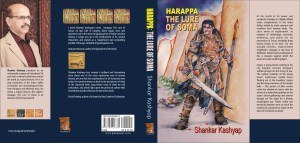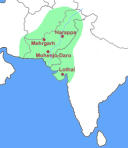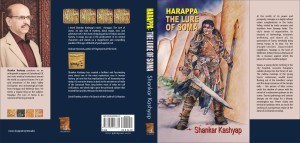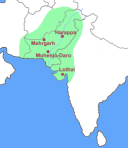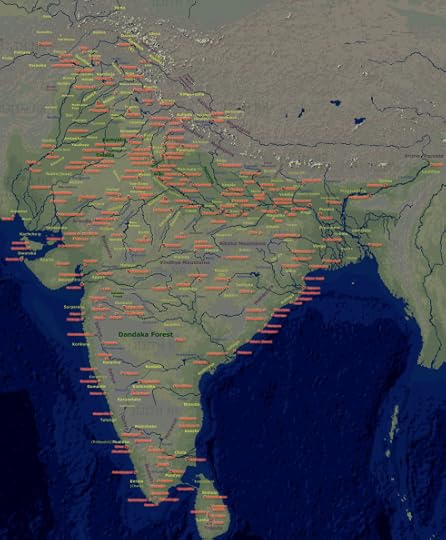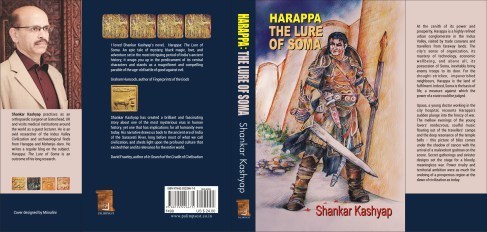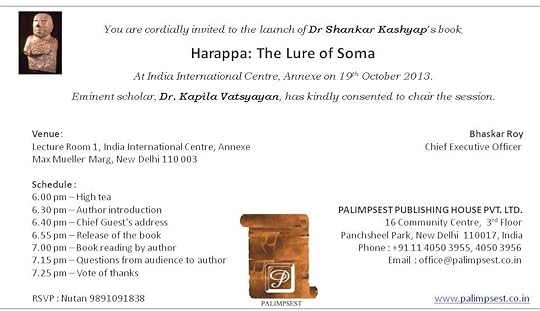Shankar N. Kashyap's Blog, page 2
November 8, 2014
The Fall of Shuruppak – the story behind the book.
The city of Shuruppak lies on the banks of one of the tributaries of Euphrates 35 miles south of the city of Nippur at the site of Tell Fara. This was probably found by Shuruppak around 3000 BCE. The city features in the Epic of Gilgamesh and come to a watery end probably around 2000 BCE. 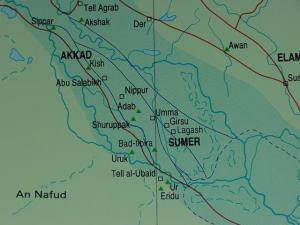
Cuneiform texts speak of warfare between cities and particularly the attacks by the Gutians. The number of tablets found in this site has given the city somewhat of a university atmosphere. These tablets feature anything from classroom texts to business deals and itemisation of object including plants and animals. The Sumerian King list puts Shuruppak as the son of Ubara Tutu, “last king before the big deluge”. King Shuruppak is known for the Instructions of Shuruppak, which is probably the oldest surviving Mesopotamian literature. Here, Shuruppak gives instructions to his son. 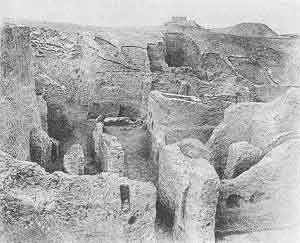 He emphasises to his son – let me speak a word to you: you should pay attention! Do not neglect my instructions! Do not transgress the words I speak! The instructions of an old man are precious; you should comply with them!
He emphasises to his son – let me speak a word to you: you should pay attention! Do not neglect my instructions! Do not transgress the words I speak! The instructions of an old man are precious; you should comply with them!
• You should not locate a field on a road
• You should not place your house next to a public square: there is always a crowd
• You should not loiter about where there is a quarrel;
• You should not steal anything
• You should not play around with a married young woman: the slander could be serious.
This is similar to the code of Hammurabi and Manu smriti and even the Ten Commandments in lot of respects. There are nearly 300 instructions found on cuneiform tablets at various levels of excavations. The earliest known tablet showing the instructions, dates back to 2500 BCE.
There are over a million cuneiform tablets discovered so far and with 130,000 tablets, British Museum leads the field. Not all of the tablets have been deciphered. Emperor Darius decides to immortalise his work on stone gets his exploits carved on the sides of the Mount Behistun in three languages. Behistun inscriptions in Persia written during the Emperor Darius’s reign had three languages – Elamite, Persian and Babylonian. This lead Henry Rawlinson, a British Officer to decipher the first Cuneiform texts in 1835. Tablets dating back to the third millennium BCE are mainly in the Sumerian language changing gradually to cuneiform texts of the classic Akkadian towards the end of the second millennium BCE. 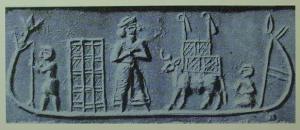
Shuruppak is not known for massive fortifications or huge Ziggurats, but is known for one of the most charismatic characters of ancient times – Ziusudra or Utnapishtim. His name is immortalised in the flood tablets of the Epic of Gilgamesh. There are over 50 flood stories across the globe in almost all the religions with a similar story’s content. Here, the Gods getting tired with looking after themselves, create a junior set of gods. But the these junior set of gods rebel at having to do all the work and the create humanity to serve them. Humans unexpectedly go forth, multiply, and become noisy. God Enlil is enraged by the noise and decides to end humanity with plagues of drought, which talk about the massive flood sent down by the angry god Enlil to end the noisy humanity. A more amicable God Enki comes to hear of this and he concocts a plan. He speaks to Ziusudra and tells him about the flood. He gives instructions to build a boat. As the flood comes, Ziusudra takes his wife, some animals and seven sages on to the boat. When the flood recedes, they land in Shuruppak and thus inhabit the world. Enki is very impressed by this and grants him immortality and sends him to live in a place “at the end of the world” in the middle of “deep dark waters” – the Apsu – so that he may not be accessible to mortals. Ziusudra turns out to be the son of Shuruppak according to the Sumerian king list. 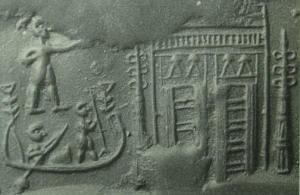
Gilgamesh is the king or Lugal of Uruk, probably the largest city after Kish during that period in pre-history. He is considered to be, two thirds God and one third human. This makes him invincible and becomes extremely arrogant. 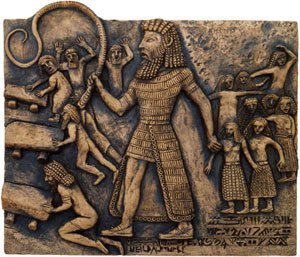 Many despise his rule. He is portrayed as a sort of a womanizer and would take any bride on the first night. The Gods hear of this and they send beautiful Shamash and the jungle man, Enkidu. The powerful jungle man is brought up by the wild animals of the jungle and grows up without any human contact until he meets Shamash and falls in love with her. When he hears of the outrage being ravaged by the king Gilgamesh, he attacks the King. The ensuing battle is bitter and long. Gilgamesh is impressed by the jungle man and befriends him. They become very close friends. Gilgamesh hears of the demon in the cedar forest, Humbaba. The legend was that the demon was the most powerful in the world. Gilgamesh could not stand someone else being called more powerful than himself. He asks for Enkidu’s help to go to the cedar forest and destroy the demon against the advice of his courtiers. They enter the forest and challenge the demon. In the ensuing fight, Enkidu is mortally wounded.
Many despise his rule. He is portrayed as a sort of a womanizer and would take any bride on the first night. The Gods hear of this and they send beautiful Shamash and the jungle man, Enkidu. The powerful jungle man is brought up by the wild animals of the jungle and grows up without any human contact until he meets Shamash and falls in love with her. When he hears of the outrage being ravaged by the king Gilgamesh, he attacks the King. The ensuing battle is bitter and long. Gilgamesh is impressed by the jungle man and befriends him. They become very close friends. Gilgamesh hears of the demon in the cedar forest, Humbaba. The legend was that the demon was the most powerful in the world. Gilgamesh could not stand someone else being called more powerful than himself. He asks for Enkidu’s help to go to the cedar forest and destroy the demon against the advice of his courtiers. They enter the forest and challenge the demon. In the ensuing fight, Enkidu is mortally wounded. 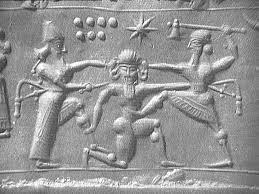 Gilgamesh brings him back to the city of Uruk along with the head of the demon. The royal physicians and all the Magi in the land try to save Enkidu in vain. Only a Meluhhan sage can save his friend. There are no Meluhhan sages in all of Sumeria.
Gilgamesh brings him back to the city of Uruk along with the head of the demon. The royal physicians and all the Magi in the land try to save Enkidu in vain. Only a Meluhhan sage can save his friend. There are no Meluhhan sages in all of Sumeria.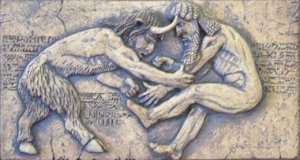
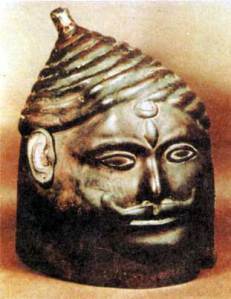 In the meantime, Sage Vasishta is on his way to the thousand-pillared temple of Varuna in Susa, the capital of Elam at the invitation of Elamite prince Shushun.
In the meantime, Sage Vasishta is on his way to the thousand-pillared temple of Varuna in Susa, the capital of Elam at the invitation of Elamite prince Shushun. 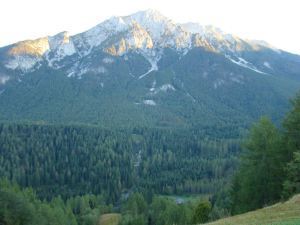 He lives on the Mount Arbuda (present day Mount Abu) in Bharata. Vasishta’s ashram is destroyed in a massive earthquake, which flattens the top of the mountains and barely escape death by the skin of their teeth. He is travelling with the hero of Harappa, physician Upaas and the prince of Elaam, Shushun. Their ships get into trouble during a heavy ocean storm and two of the three ships are destroyed. The Meluhhan immigrants in Lagash rescue Upaas’s party while the sage’s ship sails into Susa through the river Karun. They meet the translator, Shu-Ilishu in Lagash. Gilgamesh asks Upaas and his friends to help Enkidu.
He lives on the Mount Arbuda (present day Mount Abu) in Bharata. Vasishta’s ashram is destroyed in a massive earthquake, which flattens the top of the mountains and barely escape death by the skin of their teeth. He is travelling with the hero of Harappa, physician Upaas and the prince of Elaam, Shushun. Their ships get into trouble during a heavy ocean storm and two of the three ships are destroyed. The Meluhhan immigrants in Lagash rescue Upaas’s party while the sage’s ship sails into Susa through the river Karun. They meet the translator, Shu-Ilishu in Lagash. Gilgamesh asks Upaas and his friends to help Enkidu.
However, no one can save his friend and Enkidu breathes his last to the extreme lamentations of Gilgamesh. He is heartbroken and talks of killing himself. He asks why he could not save his friend if he was so powerful. Why is the human life so fragile? Why did his power not help his friend? How is the old sage Ziusudra can get immortality?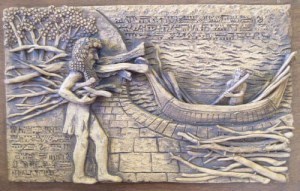
The story revolves around the epic of Gilgamesh and the trading links between Harappan and Mesopotamian civilisations. 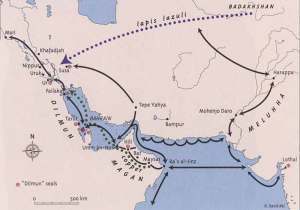 Experts agree that the Harappan ships sailed up the gulf to Sumer during the height of the mature phase in 2600 to 2300 BCE with Dilmun (Bahrain) and Magan (Oman) as intermediary ports. Later, as the two civilisations started to decline, the intermediary ports of Magan and Dilmun became terminals.
Experts agree that the Harappan ships sailed up the gulf to Sumer during the height of the mature phase in 2600 to 2300 BCE with Dilmun (Bahrain) and Magan (Oman) as intermediary ports. Later, as the two civilisations started to decline, the intermediary ports of Magan and Dilmun became terminals. 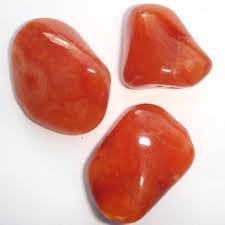 The Harappans ships brought grains, copper, Silver, Gold, semi-precious stones such as Carnelian, Lapis Lazuli, Agate and took mainly woollen material and probably silver from Sumeria. There are references to a Magillu boat (typical Harappan boat) in Sumerian cuneiform tablets including the epic tablets. Later, during the Akkadian period, there is record of meluhhan boats docking in Mesopotamian ports.
The Harappans ships brought grains, copper, Silver, Gold, semi-precious stones such as Carnelian, Lapis Lazuli, Agate and took mainly woollen material and probably silver from Sumeria. There are references to a Magillu boat (typical Harappan boat) in Sumerian cuneiform tablets including the epic tablets. Later, during the Akkadian period, there is record of meluhhan boats docking in Mesopotamian ports.  Sargon claims in one of the tablets that meluhhan ships docked in his port under his power! The cuneiform texts talk of King Gudea buying shiploads of Meluhhan wood to build the temple at Lagash. Several Harappans seals have been found in Mesopotamian sites as well as in Bahrain and Oman. Very few typical cylindrical seals of Mesopotamia have been found at some Harappan sites.
Sargon claims in one of the tablets that meluhhan ships docked in his port under his power! The cuneiform texts talk of King Gudea buying shiploads of Meluhhan wood to build the temple at Lagash. Several Harappans seals have been found in Mesopotamian sites as well as in Bahrain and Oman. Very few typical cylindrical seals of Mesopotamia have been found at some Harappan sites.
Gilgamesh is grateful to Upaas for helping his friend Enkidu during his last days and offers a reward. The friends want to meet the fames sage Ziusudra. That is a task no living being had done before. No one who had gone in search of the sage had returned alive. Gilgamesh decides that the sage may have the answers to his questions and make him immortal. He decides to go to the Apsu and meet the sage with Upaas. They meet fierce lions, demons and magical creatures on the way. The ferryman of Apsu takes them on his boat to meet the sage. The sage gives Gilgamesh a plant which can make him immortal. But he drops it into the Apsu on the return journey and loses it. 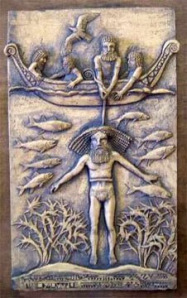
The friends return to Shurppak which comes under attack by the barbaric Gutians and is burnt down. 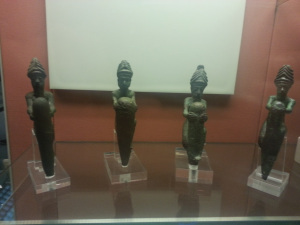 Upaas helps the burn victims and as they finally leave the city, the water rises due to incessant rain and watch both the cities of Shuruppak and Uruk submerge under water. When they finally meet up with sage Vasishta in Susa, he says –
Upaas helps the burn victims and as they finally leave the city, the water rises due to incessant rain and watch both the cities of Shuruppak and Uruk submerge under water. When they finally meet up with sage Vasishta in Susa, he says –
“….the most lasting achievements of a ruler are not buildings, walls or temples;
Since they can be swept away and turned into ruins and fields; and not power
Since the gods control all destiny,
But knowledge and humility …”


June 15, 2014
��������������� ������������������ ��������������� ������������������������ – ������ ��������������� ��������������������� ������������ ������������ ������������
My article published in my mother tongue – Kannada.
 Originally posted on ��������������� ��������������������� ��������������� ������������������������������ ��������������� ������������������ (������.������):
Originally posted on ��������������� ��������������������� ��������������� ������������������������������ ��������������� ������������������ (������.������):
������������ ��������������������������� ��������������� ��������������������������� ������������������������ ��������������������������� ������������������ ��������������������� ������������������������������. ��� ��������������� ������������ ������������������ ������������������; ������������ ������������������������ ��(The Lure of Soma) �������������� ������������ (2013)�����������������������������������
Map: CC Wiki
������������������ ���������������?
��������������������������� ��������������� ��������������� ��������������������������������� ��������������������� ��������������� ������������ ��������������� ������������������������������, ������������ ��������������� ��������������������� ������������������������������ ����������������������� ���������������������������������������������������������������.�� ��� ������������������������, ��� ��������������� ��������������� ��������������������������� ��������������������� ��������� ������������������������������������, ������������������ ��������������������������������������������������� ������������ ������������ ��������������������������������� ������������������������ ������������������ ��������������������������� ���������������������������������������������.�� ������������������������������������, ��������������� ��������������� ��������������������������� ��������������������� ��������������� ��������� ������������������������ ���������������������, ������������ ������������������, �������������������� ��������������� ��������������������� ��������������� ��������������������� ��������������������� ������������������������ ������������������������������. ��������������������������� ������������ ������������������������, ��� ��������������� ��������������� ������������������ ��������������������������� ��������������� ������������ ��������� ������������������������ ������������ ���������������������. ���������������������������, ������������.������ 1500 ���������������,�� ������������������ ������������������������������ ������������������������������ ������������������������������ ��������� ������������������������������ ������������������, ��� ��������������������������������������� ��������� ��������������������� ������������.�� ���������������������������������������, ������������ ������������������������������ ������������ ������������������������������������ ��������� ������������������������ ������������������ ������������������������������������������.������������ ���������, ������������������ ��������������������� ��������� ������������������������ ��������������������� ��������������������������������������� ���������������������������.�� ���������������������������,�� ��������������������� ��������������������� ������������������ ��������������� ��������������� ������������������ �������������������������������� ��������������������������������� ������������������������������������������������.�� ��������������������������������� ������������������������������ ���������������, ������������������������ ������������������������������������������ ���������������, ���������, ������������ ��������������������� ������������������������, ���������������������������������������������������������������������
View original 1,008 more words


ಹರಪ್ಪ ಪುಸ್ತಕ ಸರಣಿಯ ಹಿನ್ನೆಲೆ – ಡಾ ಶಂಕರ್ ಕಾಶ್ಯಪ್ ಅವರು ಬರೆದ ಲೇಖನ
My article published in my mother tongue – Kannada.
 Originally posted on ಕನ್ನಡ ಸಾಹಿತ್ಯ ಮತ್ತು ಸಾಂಸ್ಕೃತಿಕ ವಿಚಾರ ವೇದಿಕೆ (ಯು.ಕೆ):
Originally posted on ಕನ್ನಡ ಸಾಹಿತ್ಯ ಮತ್ತು ಸಾಂಸ್ಕೃತಿಕ ವಿಚಾರ ವೇದಿಕೆ (ಯು.ಕೆ):
ನಾನು ಇತ್ತೀಚೆಗೆ ಹರಪ್ಪ ನಾಗರೀಕತೆಯ ಪುಸ್ತಕಗಳ ಸರಣಿಯನ್ನು ಬರೆಯಲು ಪ್ರಾರಂಭ ಮಾಡಿದ್ದೇನೆ. ಈ ಸರಣಿಯ ಮೊದಲ ಪುಸ್ತಕ ”ಹರಪ್ಪ; ಸೋಮನ ಆಕರ್ಷಣೆ” (The Lure of Soma) ಕಳೆದ ವರ್ಷ (2013) ಪ್ರಕಟವಾಗಿದೆ
Map: CC Wiki
ನಾನೇಕೆ ಬರೆದೆ?
ಶಾಲೆಯಲ್ಲಿ ಹರಪ್ಪ ಮತ್ತು ಮೊಹೆಂಜೋದಾರೋ ಅವಶೇಷಗಳ ಬಗ್ಗೆ ಕಲಿತ ನಂತರದ ದಿನಗಳಿಂದಲೂ, ನಾನು ಭಾರತದ ಪ್ರಾಚೀನ ಇತಿಹಾಸದಿಂದ ಬಹಳಷ್ಟು ಆಕರ್ಷಿಸಲ್ಪಟ್ಟಿದ್ದೇನೆ. ಆ ಸಮಯದಲ್ಲಿ, ಈ ವಿಷಯದ ಬಗ್ಗೆ ಲಭ್ಯವಿದ್ದ ಸಾಹಿತ್ಯ ಬಹಳ ವಿರಳವಾಗಿದ್ದು, ಅದನ್ನು ದೊರಕಿಸಿಕೊಳ್ಳುವುದು ಒಬ್ಬ ಶಾಲಾ ವಿದ್ಯಾರ್ಥಿಯ ಪಾಲಿಗಂತೂ ಅತ್ಯಂತ ಕಷ್ಟಕರವಾದ ಕಾರ್ಯವೆನಿಸಿತ್ತು. ಅಲ್ಲಿಂದೀಚೆಗೆ, ಸಿಂಧೂ ಕಣಿವೆ ನಾಗರೀಕತೆಯ ಉತ್ಖನನದ ಕೆಲಸದ ಗತಿ ಚುರುಕಾಗಿ ನಡೆದಿದೆ, ಹಾಗೂ ಇದರಿಂದ, ಭಾರತೀಯ ಪೂರ್ವ ಇತಿಹಾಸದ ಬಗ್ಗೆ ನಮಗಿರುವ ಗ್ರಹಿಕೆ ಅಗಾಧವಾಗಿ ಬದಲಾಯಿಸಿದೆ. ಶಾಲೆಯಲ್ಲಿ ನಮ್ಮ ಶಿಕ್ಷಕರು, ಈ ಮಹಾನ್ ಸಿಂಧೂ ಕಣಿವೆಯ ನಾಗರೀಕತೆಯ ಬಗ್ಗೆ ನಮಗೆ ಪಾಠ ಮಾಡಿದ್ದು ಈಗಲೂ ನೆನಪಿದೆ. ಅದೇನೆಂದರೆ, ಕ್ರಿ.ಪೂ 1500 ರಲ್ಲಿ, ರಶಿಯಾದ ಸ್ಟೆಪ್ಪೀಸ್ ಹುಲ್ಲುಗಾಡು ಪ್ರದೇಶದಿಂದ ಬಂದ ಲೂಟಿಕೋರರಾದ ಆರ್ಯರು, ಈ ನಾಗರೀಕತೆಯನ್ನು ನಾಶ ಮಾಡಿದರು ಎಂದು. ದುರದೃಷ್ಟವಶಾತ್, ಅನೇಕ ವಿದ್ವಾಂಸರು ಈಗಲೂ ವಿಶ್ವದಾದ್ಯಂತ ಇದೇ ಕಥೆಯನ್ನು ಪ್ರಚಾರ ಮಾಡುತ್ತಿದ್ದಾರೆ.ಆದರೂ ಸಹಾ, ಅವರಿಗೆ ಅಗಾಧವಾದ ವೇದ ಸಂಗ್ರಹಗಳ ಸೃಷ್ಟಿಯ ಕರ್ತೃತ್ವವನ್ನು ನೀಡಲಾಗಿದೆ. ವೇದಗಳನ್ನು, ಪ್ರಾಚೀನ ಜಗತ್ತಿನ ಅತ್ಯಂತ ಬೃಹತ್ ಮತ್ತು ಗಹನವಾದ ಜ್ಞಾನವುಳ್ಳ ಗ್ರಂಥಗಳೆಂದು ಒಪ್ಪಿಕೊಂಡಿದ್ದಾರೆ. ಗ್ರಂಥಗಳಲ್ಲಿ ಅಡಕವಾಗಿರುವ ಜ್ಞಾನ, ಎಷ್ಟೊಂದು ಪ್ರಗತಿಪರವಾಗಿದೆ ಎಂದರೆ, ಇವು, ಇಂತಹ ಪ್ರಾಚೀನ ಕಾಲದಲ್ಲಿ, ಉತ್ಪತ್ತಿಯಾಯಿತೆಂಬುದನ್ನು…
View original 1,008 more words


June 1, 2014
Black Holes AND Ancient Indians
 Originally posted on shankarkashyap:
Originally posted on shankarkashyap:
Albert Einstein felt nature would not permit such things to exist despite his theory of general relativity allowed such a possibility. It was unthinkable for him to have an enormous star; hundreds of times bigger than our sun could vanish from the universe. An American journalist first named black holes in 1968 reporting on an American scientific meeting.
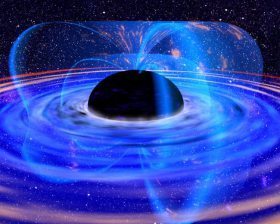 American physicist, John Wheeler was the first one to describe an area of space which was “empty” and which “swallowed everything” including light. Pierre-Simon Laplace and John Mitchell considered that such objects existed where the gravitational force was so great that light cannot escape in 18th Century, and were called “black stars” or “cold stars“. In ancient Indian scripture, Mandokya Upanishad, probably composed around the second millennium BCE, talks about Vishwaruchi, which absorbs everything in the universe – Black Hole.
American physicist, John Wheeler was the first one to describe an area of space which was “empty” and which “swallowed everything” including light. Pierre-Simon Laplace and John Mitchell considered that such objects existed where the gravitational force was so great that light cannot escape in 18th Century, and were called “black stars” or “cold stars“. In ancient Indian scripture, Mandokya Upanishad, probably composed around the second millennium BCE, talks about Vishwaruchi, which absorbs everything in the universe – Black Hole.
Black holes were considered as scientific curiosities in the…
View original 1,430 more words


May 12, 2014
The Last words of an Old King
The mellow sun cast a charm all over the palace. The royal garden was full of flowers and trees swayed with an abundance of fruit. Clusters ofamras and satphalas were swinging in the southern breeze. A squirrel curiously looked at the bunches of mangos and pomegranates glistening in sunlight. Deer pranced around and the parakeets and cuckoos from the top branches. His two beautiful wives were on either side of him on the swing. All was well with the world of King Yayati. He was the master of an empire extending from the majestic peaks of the Pariyatra Parvatha in the west to the turgid sea in the east, from the sublime Himalayas in the north to the ocean in the south. He smiled thinking of the vastness and diversity of the territory under his sceptre. The harsh Parvatha leading to Central Asia acted as a boundary preventing the nomads and tribes from entering his kingdom. The sharp bay in the east with its greenish, muddied water separated his huge land mass from the Arakanese and Malaya people deep in the east. And the sapphire waters of the quiet sea in the south were like a shield against the Mleccha’s world. The monarch had five lovely children just coming of age and supporting him in administering the vast empire of Ilavarta. 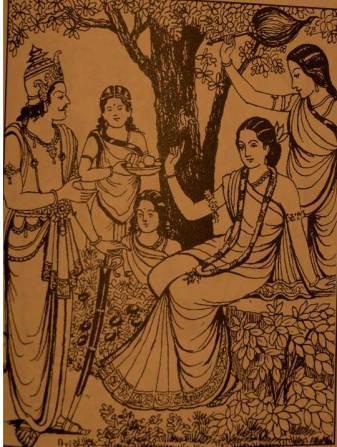 The heady fragrance from the long tresses of Sharmishta soothed him. Lying on her downy lap he breathed deeply. Ah! The sweet smell from her hair was more overpowering than the seasoned wine he had just had. The indolent breeze in the royal garden and the twittering of parakeets were suddenly disturbed by the thundering voice of Sage Shukra,
The heady fragrance from the long tresses of Sharmishta soothed him. Lying on her downy lap he breathed deeply. Ah! The sweet smell from her hair was more overpowering than the seasoned wine he had just had. The indolent breeze in the royal garden and the twittering of parakeets were suddenly disturbed by the thundering voice of Sage Shukra,
“King Yayati, what is happening here? This is disgraceful behaviour indeed! How can you be consorting with her in front of my daughter?”
King Yayati jumped off the swing, in his haste nearly dropping Sharmishta on to the ground. He fell at the feet of the Sage and said, “My sincere apologies, oh great sage. If I had only known that you were coming .…”
The sage stepped back and kept fuming. “You would have carried on with your amorous activities with Devayani’s maid despite my express command not to do so. She was sent to serve my daughter, not you. You have forgotten your promise at the time of your marriage to Devayani.” His face was flushed with rage and the ears turned red. “It is not your fault. Your reckless youth is leading you astray. I am cursing you, your youth will turn into a heap of waste in no time.”
As Yayati stood trembling, his hands clasped, the Sage poured some holy water from his kamandalu and sprayed it on Yayati. Devayani looked at her husband with fear and shock in her eyes. “My Lord, your face,” she screamed and closed her eyes. A moment later she ran to Sage Shukra and said, “Father, what have you done? What will happen to me now?” 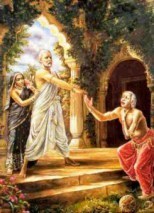
Yayati ran to the fountain and looked down to see an old man staring back at him. He had aged phenomenally within minutes. The face was wrinkled like an old bark peeling off at the edges, drooping eyelids with dull lacklustre eyes. He brought up his hands in shock to see rotting gnarled fingers swollen with arthritis. He suddenly found that he could barely move because of the acute pain in the joints.
Sage Shukra took his beloved daughter in his arms and could feel her little heart pounding against his chest. He could hear the cry surging out of her soul. He had brought up on his own after the death of his wife. The rage that had passed through his body like a sharp current seeing his son-in-law cavorting with the lowly maid began to recede. He calmed down and the red mist lifted from his eyes. He looked at his sobbing little girl and felt a stabbing pain in his heart. ‘What have I done to my only daughter? I have ruined her life in an instant.’ He turned to King Yayati and said, “A curse once uttered cannot be taken back. But, I’ll let you exchange your old age with one of your five children.” 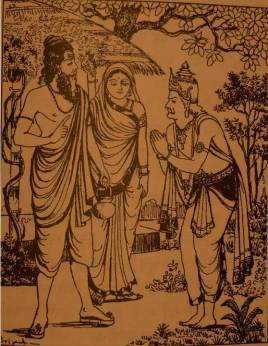
“Thank you, Great Sage for showing me mercy.” Yayati bowed deeply and sat down, tired. Devayani sent the royal servants to bring the five children to the garden. The eldest son Yadu was the first one to come. He was a tall, strapping young man with stunning good looks. His taut, toned body vibrated with strength and masculinity. He came into the garden and touched the feet of the Great Sage, and then his parents’. The other four followed suit. Both of them blessed all of them with “Deerghayushman Bhava!”
Yadu was the first one to speak,
“You sent for me, Mother? What can we do for you? Where is our father? Who is this elderly gentleman wearing Father’s regalia?” He was staring at the old man intently as he spoke.
“I am your unfortunate father, son. I have been cursed because of my lapses. Sage Shukra has granted that I can regain my youth by swapping my old age with the youth of one of my sons.” Yayati looked at Yadu with pleading eyes.
“But Father, that is shocking news. I have just stepped into my youth and I have not had the taste of it yet. How can I give it away before I even know what it feels like?”
Disappointed, Yayati next looked at Turavsha who would not consider it either. He then turned to the sons of Sharmishta. Dhruhyu looked away turning down his request. Anu had contempt in his eyes when he said, “Was it not you, Father, who told me that a man has to pay for his follies? Why are you asking the others to pay for your actions now?” He had always felt that he was the neglected one among the children.
Puru, the youngest son, who was watching quietly all the while, spoke up. “Father, I haven’t tasted youth and hence I am not going to miss it. If it means that much to you, please have my youth. I will gladly take your place in the forest with Sage Shukra.”
He went to the sage and touched his feet. The sage blessed him with “Deerghayushman Bhava” and lifted him up holding his shoulders. In a matter of moments the young Puru was metamorphosed into an old man and Yayati regained his good looks. He took Puru in his arms and said, “You are the real son for me. From today onward you will be called Sudas because of your actions.” Sharmishta held her son in her arms and kissed his forehead. Tears were flowing down her cheeks as she bid goodbye to him. Puru struggled to bend down to touch the feet of his parents – Yayati, Devyani and Sharmishta – before leaving for the forest with Sage Shukra. The royal couple and the four sons stood there as the cart carrying Puru and Sage Shukra disappeared in the distance.
Yayati went back to what he had always been good at – ruling the empire and enjoying his youth with his two beautiful wives. The empire of Ilavarta was flourishing with the surplus of the sacred Soma plant, bountiful forests and happy subjects. He developed several cities along the river Sindhu to the same level as those along the Sarasvati. He built ports at the mouth of the Sarasvati for the large ocean going ships. He provided safe drinking water and food for all the subjects. The culture and cultivation of knowledge rose to a new level with the studies of medicine, science, engineering and astronomy in the kingdom. Men from far flung countries such as Sumeria, Elaam, China and Egypt were visiting Ilavarta to learn. He soon forgot his son Puru and the episode with Sage Shukra. His sons were growing up, strong and powerful partners in administering the empire. But, it was not the same. He always thought that there was something missing.
One day while in the forest for a hunt, he saw a group of young deer grazing in a clearing. He stopped his horse and took careful aim at a shiny stag. As he drew his bow and shot the arrow, an older deer ran across and was hit by the arrow. As the king came close to the dying deer, he realised what had happened. The father of the herd had put himself in line of the arrow to protect the young stag. Yayati was taken aback. An animal sacrificed himself to save his baby. He pulled the arrow out and ordered his servants to nurse the deer back to health and rode his horse hard towards Sage Shukra’s ashram.
It was getting dark by the time he reached the ashram. The sage was getting ready for the evening yajna. He waited outside the door till the rituals were over and approached the sage with folded hands as he stepped out.
“Welcome King Yayati, I know why you are here. I knew you would realise your folly and come to your senses sooner or later. Are you now ready to fulfil your obligations?” Shukra said.
“I have made a great error of judgement, oh great sage. Please forgive me. I am prepared to accept my punishment and responsibilities.”
“It is not me who should forgive you. You have to ask your son Puru to forgive you. You have wronged him deeply.”
Yayati turned to Puru who was standing silently by the side and held him in his arms. Tears rolled down his cheeks as he said, “Please forgive me, son. You have made the ultimate sacrifice for your father and showed me who is a greater man. I want to give back your youth. Please accept it.”
“I did what any dutiful son would do, Father. I will do it again willingly if asked to.”
Yayati turned back at the sage with pleading eyes and begged him to transform him into a young man again. The sage closed his eyes and uttered some hymns and sprayed both of them with the holy water from his kamandalu. Puru stood in front of him as a handsome man in the prime of his youth and Yayati turned into a wizened old man.
“I am eternally grateful to you, oh great sage. Now, it is time for me to retire deep into the forest to meditate. My children are old enough to look after the empire,” Yayati said. Young Puru took his father’s hand and led him to a seat covered with grass. “Please bring your brothers to me,” the king, afflicted by decrepitude, said.
The five brothers and the king’s two wives assembled in the courtyard of the sage’s ashram. Yayati was led in by the sage himself.
“Sons, our land is exuberant with bounty from Pariyatra Parvatha to the mouth of the Jahnavi River in the east and from the snow-crested Himalayan peaks to the ocean in the south. One day this river will be revered as the holiest of holy water flows. I have consulted Sage Shukra and come to a decision.” Yayati turned to his five sons. “Son, Yadu. You are the eldest, and I think, the most mature. I want you to look after the lands where our two great rivers, the Sindhu and the Saraswati join the ocean. I want you to look further across the seas in the future.”
Yadu smiled and thanked his father.
“I will make you proud, Father. I will take the flag of our land, Ilavarta, to the world.”
“I am sure you will, son. I am certain of that. Your descendants will make the land proud. Among them will be a brilliant man, a dark complexioned prince, who would give counsel to the protagonist of the great eighteen-day war.” Turning to Turvasa he said, “Son, I want you to take care of the sacred banks of the Rasa and the hoary Arbuda mountains. Thousands of years from now when water will be scarce and demand for it much more, they will fight for the share of the Rasa water and take their battles to court calling the river Narmada. And the Arbuda mountains? Oh yes, their cool climes will beckon the people sick of city life. The sages of Arbuda need protection from the demons and dasyus.”
“Father, you can rest assured that I will not let any harm befall our sages and elders of Arbuda,” Turvasa replied.
Yayati could see Sharmishta looking anxiously at him to see what he had in hold for her sons. Yayati smiled when he spoke to Druhyu. “Son, you are the strongest of all my sons. Our land needs someone to protect its mountains and the source of our waters and sacred Soma. I want you to look after the valleys and mountains of Pariyatra Parvatha.”
“You can rely on me to protect our treasures, Father,” Druhyu said with a serious look on his face. His descendants eventually went down to become the celebrated Gandharis. The king called Puru to come forward and held his hands. “My dear Puru, you are the only son who fulfilled a father’s desire without thinking. You are the true Sudas, the good disciple. You will carry the name of the family and your sons will bring glory to the land of Ilavarta. You will take care of the rest of the empire from the most sacred land of all on the river Saraswati. The land will be known by the name of your descendants. One of them, a lion-hearted able ruler, to be called Bharata by his sorrowful mother, will lend his name to this vast land which for the experts down the ages would only be a little less than a continent.”
The gasps of breath were quite audible as the sons not yet called looked sullen and stunned. A frosty silence followed. Finally, Devayani broke the silence. “My Lord, what about our son Anu? What about his share of the land?”
Yayati burst out laughing and looked at both Devayani and Sharmishta.
“True to motherhood, both of you must treat all the sons equally. Our sons don’t show the same affection. You have forgotten that Anu didn’t even bother to help me when I was struck down by Sage Shukra so many years ago. Nothing is due to him. He has no right to any part of my empire. But I will do my fatherly duty.” Turning to Anu, he said, “You can look after the end of the land where the two great rivers Jahnavi and Bramhaputra rage into the sea, where marsh lands are covered by dense forests.”
“Thank you, Father. I will look after the land and make it as it should be – a fertile fruitful land you can be proud of. I will work hard and it will be my penance for neglecting my duty as your son.” Anu looked to the ground, his head bowed.
“Sons, the lust for power and craving for the land will prompt hungry leaders to go to war again and again for thousands of years to come. They will shed blood for a little valley here and a bowl of water there, soldiers for years are going to keep vigil over a chunk of snow. Power, palaces and politics will be the undoing of my beautiful land.” King Yayati looked sad.
An old, wizened and now wise man, Yayati left Shukra’s ashram for the dark deep forests to spend his remaining days in meditation and seek salvation, his two wives in tow. Turning back from the wicker gate, he took one last look at his children. “Sons, from tomorrow onward you are the rulers of huge kingdoms. Keep it in mind in a war there are no winners, both sides lose. So find ways to delay a war and sit with your foes and seek answers to all the problems. Remember together we lose a war.”


May 7, 2014
Harappa Series – A Preamble!!
I have been fascinated by ancient history of India since I was taught about the ruins of Harappa and Mohenjodaro in school. The literature available at that time was scant and extremely difficult to obtain. Particularly to a school kid! Since then, work on excavations on the Indus Valley Civilization has gathered pace and it has changed our perception of Indian pre-history enormously. I still remember our teachers teaching us about the great Indus Valley Civilization and its destruction by the plundering Aryans from the steppes of Russia in 1500 BCE. Unfortunately, scholars are still propagating that story across the world. 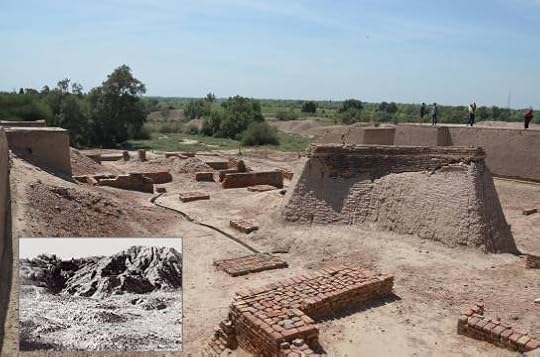
As I grew up, I found it difficult to understand how a thriving and advanced civilization ended so suddenly beyond any trace. There were several inconsistencies in the story. These brigands were supposed to have ridden horse drawn chariots across mountain passes and valleys. 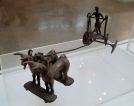 The chariots, especially fast two wheeled chariots are suitable only in flat plains and not on mountains. Despite extensive search among archaeological literature available, I could not find any evidence put forward for mass destruction or conflagration associated with such a massacre in any of the ruins. No mass graves, no fire destroyed cities, no wanton destruction of any of the buildings. These Aryans are portrayed as barbaric and uncultured brutes, more interested in pillaging villages and stealing cattle than intellectual pursuits. Yet, they have been given the authorship of the enormous Vedic corpus. The Vedas are acknowledged as the biggest and most profound scriptures of the ancient world. The knowledge contained in the texts is so far advanced, that it is difficult comprehend that it originated in pre-history.
The chariots, especially fast two wheeled chariots are suitable only in flat plains and not on mountains. Despite extensive search among archaeological literature available, I could not find any evidence put forward for mass destruction or conflagration associated with such a massacre in any of the ruins. No mass graves, no fire destroyed cities, no wanton destruction of any of the buildings. These Aryans are portrayed as barbaric and uncultured brutes, more interested in pillaging villages and stealing cattle than intellectual pursuits. Yet, they have been given the authorship of the enormous Vedic corpus. The Vedas are acknowledged as the biggest and most profound scriptures of the ancient world. The knowledge contained in the texts is so far advanced, that it is difficult comprehend that it originated in pre-history.
I remember sitting at home during poojas wondering what the priest was saying as he recited the hymns in front of deities. My questions as to what he was saying was usually met with – “It is from Rigveda”, “it is a hymn to propitiate the Gods” or “it will bring you whatever you want”. I am not too sure if the priest himself knew the exact meaning of the hymns he was reciting. I was curious to find out about these scriptures, which have been passed on for millennia by word of mouth.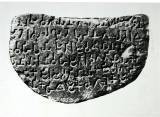
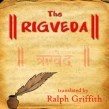
There have been a raging debate about the authorship of the Vedas for several decades. Hindus believe that the Gods revealed the scriptures to the Rishis and in turn, they formatted the hymns of the four Vedas. Hence, the term “Shruthi” – “heard” has been given to these texts. They have been attributed to the Aryans of Russian origin, but composed in the land of Punjab by some scholars. Ancient Dravidians. They have been attributed to the people of Latvia, Hittites of present day Turkey, Avestans of present day Iran and Dravidians by various people backed up by philological and liturgical. The evidence put forward for these are rather tenuous and will not stand up to scrutiny. Even the timing of the composition has been controversial – dating from 6000 BCE to 900 BCE. It is generally accepted that these were composed over a period of 600 years from about 1500 BCE. Then again, the evidence for this is based on opinions of individuals and tenuous philological evidence.
Evidence is emerging to the possibility that the Vedas were composed by the very people who were said to have been destroyed by the invading Aryans – the Harappans. Rigveda has several events, giving the date and place of its composition. Seventh Mandala (seventh book) of Rigveda describes the sun to rise in Orion during vernal equinox. We know from the calculations, that this would be around 4000 BCE. That would mean either the event took place in 4000 BCE or the author was living in 4000 BCE. River Sarasvati is central to the Rigveda. Several hymns are dedicated to the river. Many events are described in relation to a mighty river and the biggest river of its time, which was flowing east of the present river Ravi (called Parushni). We now know that there was a massive river flowing from the Himalayas in the region of Manas Sarovar to the Rann of Kutch in Gujarat through the deserts of Rajasthan. This river started to dry up around 1900 BCE and completely dried up around 1300 BCE, leaving two segments of seasonal rivers – Gaggar and Hakra of the present day. NASA satellite images have shown the presence of a wide river about 100 meters below the surface along what is considered the path of river Sarasvati. The river dried up due to numerous tectonic events and gradual moving of Northeast monsoon more eastwards during the second millennium BCE. Earliest recorded earthquake in this region is 2600 BCE (B B Lal). This puts the composition of the Vedas before 1900 BCE – maybe sometime during the third millennium BCE. 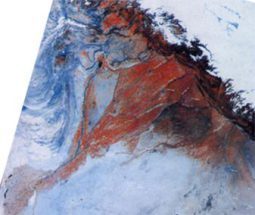
One of the arguments used by the Aryan Invasion Theorists is the use of Iron in the Vedas. The term ‘Ayas’ has been translated to Iron, moving the text to the Iron Age ie after 1500 BCE. Several Sanskrit scholars now interpret this to mean “metal” rather than “iron”. Hence, it could be any metal, including Copper and Bronze. The second argument put forward by the AIT theorists is the use of horses in the events described in the Rigveda and they claim that horses did not exist in India until the second millennium BCE. Archaeological evidence of true domesticated horse bones has emerged from the ruins of Dholavira, Mohenjodaro, in all layers in Surkotada, Kalibangan, and Rupar and even around Harappa dating back to 3000 BCE.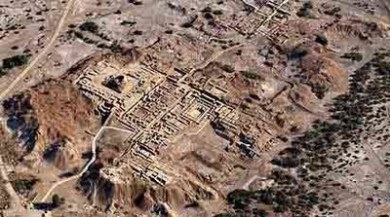
Several people now firmly believe that the Harappans were the composers of the Vedic scriptures and I am one of them. There is an enormous amount of literature available on the internet on Harappan civilization as well as the Vedas. It is difficult to sort out the wheat from the chaff. I looked for books on the subjects. Again, there is an enormous amount of books out there on these subjects. They all into one of the three categories. Most obvious ones are written by scholarly historians – extremely dry and difficult to read and understand. Second, which is probably the most frequent – written by people with propaganda as the main object. Some of them bordering on being Hindu fundamentalists. The third category is the most interesting – books written with the common man in mind and almost story book form.
However, I did not find one that would keep our young people interested in the Indian prehistory and our scriptures. I came across books written about Egyptian, Greek and Roman history written in fictional form. These were very interesting to read and attractive to young people. This started my tryst with the Harappan series of books. These books will hopefully be of interest to young people and propagate our ancient culture. This might even make them read more about our cultural history of the past.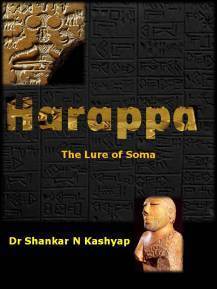
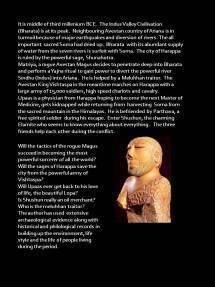
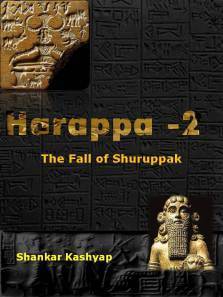


February 12, 2014
Harappa: The Lure of Soma – a preface.
There has been a controversy raging over the years as to who were the people living in the Indus Valley ruins. It ranged from native “Dravidians” to “Aryans” from the steppes of Russia. Evidence is emerging over the last few years for natives who might have developed what we know of as “Aryan culture.”
Middle of the third millennium BC was the golden era of Indus Valley Civilization or Harappan Civilization. It stretched from the river Indus and Hindu Kush mountains in the west to the Ganges-Yamuna doab in the east, Himalayas in the north and the Arabian Ocean in the south. The area was over a million square miles and the biggest empire of the time, bigger than Sumerian or Egyptian civilizations put together.
After the Last Glacial Maximum about 13,000 years ago, the Himalayan glaciers receded just far enough north to leave a vast fertile alluvial plain between the Hindukush mountains in the north west and the Aravalli hills in the east. This area was flooded every year like a clock work by the river Indus. This vast land was fed by waters of seven great rivers – Sindhu (Indus), Parushni (Ravi), Vitasta (Jhelum), Vipasa (Beas), Sutudri (Sutlej), Asikni (Chenab) and Saraswathi (Gaggar-Hakra).
The Indus Valley civilization was at the peak of development in the middle of the third millennium BCE with several large urban centers such as Mohenjodaro, Harappa, Kalibangan, Dholavira and Rupar. 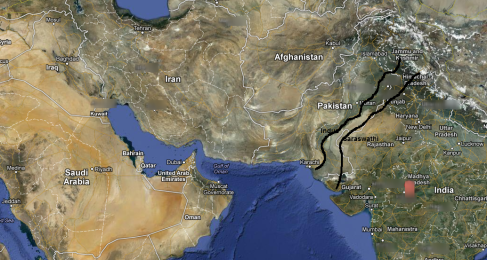 The excavations show uniform developments across the area, suggesting area wide communications, exchange of ideas and resources across the vast land.
The excavations show uniform developments across the area, suggesting area wide communications, exchange of ideas and resources across the vast land. 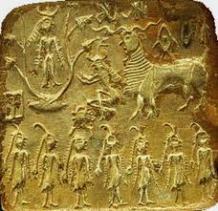 The Harappan seals have been discovered as far away as Mesopotamia and Egypt in the west and in places at the southern tip of Indian sub-continent, suggesting travel and communications over vast distances. This vast civilization appears to have disappeared around 1900 BCE. There are several theories for their demise.
The Harappan seals have been discovered as far away as Mesopotamia and Egypt in the west and in places at the southern tip of Indian sub-continent, suggesting travel and communications over vast distances. This vast civilization appears to have disappeared around 1900 BCE. There are several theories for their demise. 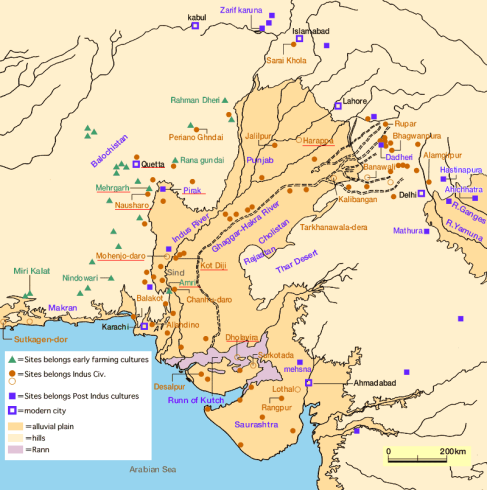
The question of who were these people has been asked for centuries. Not many people subscribe to the “Aryan Invasion” theory anymore. It is now generally accepted that the population of Indus Valley civilization was made up of indigenous people and there was a gradual migration and integration of Indo-European speaking people from the central Asia. During the nineteenth and twentieth centuries, it was probably difficult for scholars to accept that such an advanced civilization could have pre-dated a population which they considered lacking in cultural development. The conclusion that there was an “invasion” of the Aryans from the steppes of central Asia was drawn based on tenuous philological evidence. So far there has not been any evidence to suggest mass destruction or warfare among the ruins that have been excavated so far to suggest any invasion. There is, however, a grain of truth in that the warfare was conducted in battle fields rather than the cities being attacked or ransacked during the pre-history.
There are still thousands of sites waiting to be excavated. The excavations so far have revealed a highly advanced civilization with well-developed city planning, including roads, engineering, water supply and drainage. Some of the discoveries show that the system of drainage could be compared to modern day. The IndusValley script still defies our experts and remains a mystery. Very little was known about the people who lived in these cities until recently. Now we know what they looked like, what kind of clothes they wore, their jewellery, their food habits and religious practices to some extent. 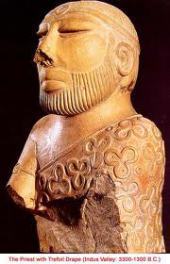
All the cities of Indus Valley Civilization show an extremely high standard of engineering and mathematical skills not seen in any other contemporary civilization elsewhere in the world. For example, all the high streets of the large cities such as Harappa and Mohenjodaro were set in major cardinal axes. For such an achievement a sound knowledge of astronomy and mathematics along with engineering skill was essential. Mathematical texts ‘written’ by eminent sages such a Baudhayana, Apastambha, Manava and Katyana have been placed between 800 BCE and 200 BCE. The dating again is based purely on linguistic evidence comparing with other contemporary texts. Apasthambha described both Pythagorean Theorem and Pythagorean triples dating at least 200 years before Pythagoras.
There is a school of thought, which subscribes to the idea that the Vedas were composed by the Harappans or the Meluhhans as the Meopotamians called them. Rig Veda is the oldest of the Vedas and has been dated to have been composed around 1700 BCE. Niraj Mohanka of New Dharma takes it even further to 4000 BCE as the timeline for Rigveda. There was no archaeological evidence to suggest the dating of the Vedas until recently. This was based purely on linguistic and philological evidence. The evidence, hence is within the books themselves. However, evidence is emerging now that the Vedas might have been written a long time ago during the Bronze Age dating back to 3000 BCE. There is now both archaeological and textual evidence emerging which show that both the Vedas and Harappans belong to the same time period. One of the grammar texts – Rigveda Pratisakya – used for analysis and understanding of Rigveda has been dated back to between 3100 and 800 BCE. New evidence is emerging all the time, which is putting our history further and further back. It will not be long before the Indus script is unravelled and we may get an answer to if the Harappans wrote the Vedas.
Rig Veda is the oldest of four Vedas – Sama, Yajur and Atharvana. It is organised into ten books or ‘Mandalas’ and consists of 1028 hymns. The numbering of the books is rather arbitrary and again based on linguistics. For example, the first book of the Rigveda in considered much younger than the second. The language of the Vedas was considered ‘archaic’ as long ago as the time of the great grammarian, Panini, who has been dated to have been around the sixth century BCE. Dr David Frawley suggests that the positioning of the vernal equinox in the Vedic scriptures suggests that the authors were from 6000 BCE. Astronomical configurations shown in the Vedas and Bramhanas suggest that these were written well before 3000 BCE. I recommend a visit to www.Indiahistoryonline.com. It has an excellent link to an extremely well researched chronology of history, not only the Vedic people but also other religions of the world.
Zarathustra (Zoroaster) is considered to be the author of religious text of the Avestans, Yasna Haptanghaiti. This has been dated to around the middle of the second millennium BCE. Geography of Ariana is quite clear in the book and puts in squarely in present day Iran and to some extent Afghanistan and north-west Pakistan. There is very little known about people who lived in these parts before Zoroaster. According to the Avestan Gathas, he teaches the Avestan King Vishtaspa and overcomes obstacles placed by other priests and ruling classes. The dating of both these individuals has been severely contested, some placing Zoroaster from 700 BCE to as far back as 7000 BCE. The language used in the Yasna Haptanghaiti is old Avestan and the date of the language is still contested.
There is archaeological evidence to show that there were significant tectonic activity in the area and several of the rivers were diverted during the second and the third millennium BCE. Diversion of several major rivers left parts of the country barren and unliveable. Even now, Greater Iran shows seismic activity with regular earthquakes.
It is in this context that the lives and trials and tribulations of people living in the Indus valley during the middle of the third millennium BCE are tackled in this book. I have used existing archaeological evidence along with known historical evidence in writing this book. I have used some poetic license to accommodate the dates and times of various individuals and events to suit the story telling. The book tries to portray the life of ordinary people during the period of the Harappans, while trying to tell the tale of the priestly kings, Magi, Rishis and Sages of the great Indus Valley Civilization during the middle of the third millennium BCE. This is the story of our hero, Upaas, a trainee physician from Harappa. It is a story of a young man growing up, falling in love, getting involved in adventures and finally fighting for the city he loves most – Harappa. The story shows the human elements of people around him. He faces friendship, love, hate, jealousy, treachery and deceit in day to day life. There is generous sprinkling of magic and sorcery. As the country of Ariana, west of Hindukush dries up, the Avestans facing with near extinction take up arms against their neighbours to obtain the precious Soma. The tactics used include deceit, sorcery and finally a war between the Meluhhans and Avestans. 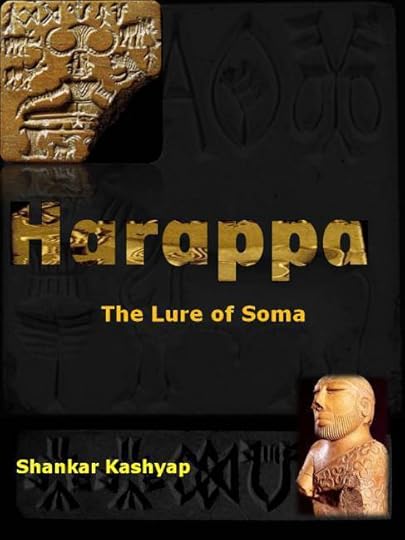
The Soma plant has been the centre piece of several hymns in the Vedic scriptures. It is a plant still not accurately recognized. The Vedic people revered it as a God, drank the extract from the stalk of the plant, used the plant for medicinal purposes and it is supposed to have magical properties. The Avestan had a similar plant and called it Haoma and their scriptures also revered the plant for its spiritual properties. Vedas describe it as growing in a sacred mountain around a sacred lake (Mount Mujavant and Lake Sharynavat). Avestan scriptures describe a similar sacred mountain and a sacred lake in Sistan where the Haoma plant grew. Similar to the Soma of Indus valley, we still do not know exactly what this plant was as it disappeared at the same time as the Harappans.
This is the first book of the Harappa Series and was launched in New Delhi in October 2013. It is now available on line at http://www.amazon.co.uk and ebook can be downloaded from Kindle to your PC/Tablet/Laptop/Smartphone.
Second book of the series, Harappa2: The Fall of Shuruppak is due for release in spring/summer of 2014.


November 12, 2013
The Book Launch Tour!!
 Reblogged from shankarkashyap:
Reblogged from shankarkashyap:
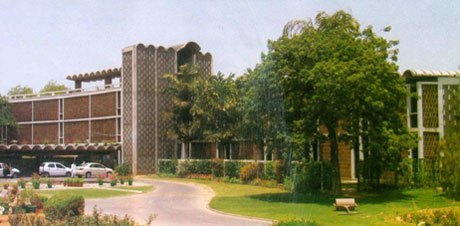








The whole thing was like out of a dream! From the moment we landed at the sprawling Delhi International Airport the events rolled quickly and merged into one long episode. The publisher, Mr Bhaskar Roy came to meet us at the Royal Plaza hotel on Janpath, right in the middle of the city jostling with swank colonial buildings of yesteryears. He took us through the following evening's timetable and tried to reassure my frayed nerves.
October 3, 2013
Great News – Book Launch finally here!!
It gives me a great pleasure to announce the Book Launch of Harappa:The Lure of Soma on 19th October at India International Centre, New Delhi. Dr Kapila Vatsayan, the noted scholar/historian, author of numerous books and winner of several awards including Sangeeth Natak Academy award and Padma Vibhushan will be the Chief Guest.


October 1, 2013
Who was Manu?
 Reblogged from shankarkashyap:
Reblogged from shankarkashyap:
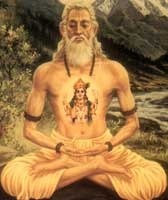
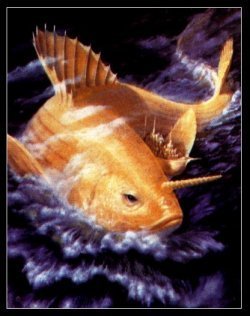
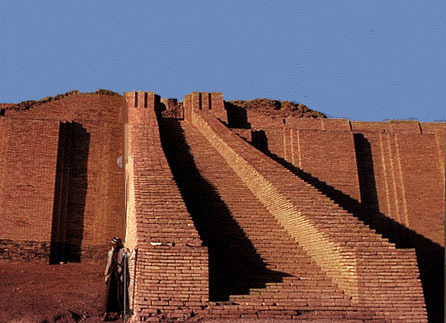

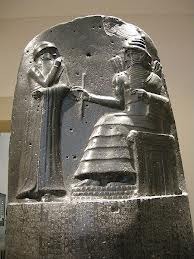
Was he the biblical Adam, the progenitor of all mankind as most ardent Hindus would have us believe? Was he the original sage, a Noah or Utnapishtim of Hinduism, who escaped the great flood and saved the mankind? Was he the first king of kings who ruled the earth? Was he the lawgiver, a Hammurabi or Shulgi or Moses of India?


